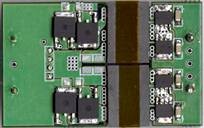LIBRARY
High-Frequency Brick Type DC/DC Converters

To support the technology trend, industry attempts to pack more functionality and advanced power hungry processors onto each circuit board together with the customized miniaturized power ¾ point-of-load (POL) converter. A POL converter is used to isolate and convert the intermediate bus voltage to a precisely regulated core voltage. After decades of effort, industry has pushed the switching frequency to several hundred kilohertz, in the state-of-art POL converter, in an attempt to pack more current within smaller footprints. Increasing the switching frequency will shrink the size of the passive components, the inductors and capacitors. The Center for Power Electronics System (CPES), an engineering research center headquartered at Virginia Tech, developed patented technologies enabling a multi-megahertz converter with integrated magnetics that uses energy saving soft-switching and gate drive techniques. At such a high switching frequency the passive components are minimized in size and number, thus saving cost and valuable footprint area.
In addition to the POL type converters, CPES has developed a bus converter that changes the POL converter into an even more distributed power system. The bus converter will convert the DC bus voltage to a lower isolated voltage, such as, 5- or 12-volts. Then a very small, non-isolated converter will perform very efficient high frequency low voltage conversion to 0.8 ~ 1.2-volts output. Although, the bus converter concept is not new to industry, the CPES designed bus converter can deliver two times more power, in the same area, as the state of the art bus converter. These power converters are just one way in which CPES helps solve future telecommunications power demands.























































































